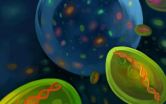(Press-News.org) Combining the estrogen hormone estriol with Copaxone, a drug indicated for the treatment of patients with relapsing forms of multiple sclerosis (MS), may improve symptoms in patients with the disorder, according to preliminary results from a clinical study of 158 patients with relapsing remitting multiple sclerosis (RRMS). The findings were presented today by Rhonda Voskuhl, M.D., from the University of California, Los Angeles, at the American Academy of Neurology Annual Meeting in Philadelphia. The study was funded by the National Institute of Neurological Disorders and Stroke (NINDS), part of the National Institutes of Health; and the National Multiple Sclerosis Society.
"While these results are encouraging, the results of this Phase II study should be considered preliminary as a larger study would be needed to know whether benefits outweigh the risks for persons affected by MS. At present, we cannot recommend estrogen as part of standard therapy for MS. We encourage patients to talk with their doctors before making any changes to their treatment plans," said Walter Koroshetz, M.D., deputy director of NINDS.
MS is an autoimmune disorder in which immune cells break down myelin, a protective covering that wraps around nerve cells. Loss of myelin results in pain, movement and balance problems as well as changes in cognitive ability. RRMS is the most common form of the disorder. Patients with RRMS experience relapses, or flare-ups, of neurological symptoms, followed by recovery periods during which the symptoms improve.
Numerous laboratory studies have suggested that estrogen may have neuroprotective effects and may help decrease inflammation, which occurs in MS. In addition, it has been reported that MS patients experience improvement in symptoms during the phase of pregnancy when levels of estrogen increase. However, studies looking at the effects of estrogen therapy on women's health have shown mixed results. Estriol, the form of estrogen examined in this study, is only produced in the body during pregnancy.
In this two-year study, patients received Copaxone along with 8 milligrams per day of estriol or placebo pills. The primary goal of the trial was to determine if estriol helped decrease the number of relapses experienced by RRMS patients who were also taking Copaxone.
Researchers found that at 12 months, estrogen combination therapy was associated with a greater reduction in relapse rates compared to Copaxone and placebo. However, at 24 months, the difference between the treatment groups was not as great as it was at 12 months.
"The findings presented by Dr. Voskuhl suggest that there may be benefits to supplementing Copaxone therapy with estrogen. A longer study, with more patients, would be necessary to definitively validate these provocative, although early, findings," said Dr. Koroshetz.
INFORMATION:
The work was supported by grants from the NINDS (NS051591) and the National MS Society who are deeply grateful for the patients who joined the research, and the research teams that carried out this important work.
For more about MS, please visit:
http://www.ninds.nih.gov/disorders/multiple_sclerosis/multiple_sclerosis.htm
NINDS is the nation's leading funder of research on the brain and nervous system. The mission of NINDS is to seek fundamental knowledge about the brain and nervous system and to use that knowledge to reduce the burden of neurological disease.
About the National Institutes of Health (NIH): NIH, the nation's medical research agency, includes 27 Institutes and Centers and is a component of the U.S. Department of Health and Human Services. NIH is the primary federal agency conducting and supporting basic, clinical, and translational medical research, and is investigating the causes, treatments, and cures for both common and rare diseases. For more information about NIH and its programs, visit http://www.nih.gov.
Preliminary results show improvement in MS symptoms
NIH-funded scientists look at combined therapy, but call for further research
2014-04-29
ELSE PRESS RELEASES FROM THIS DATE:
Octillions of microbes in the seas: Ocean microbes show incredible genetic diversity
2014-04-29
The smallest, most abundant marine microbe, Prochlorococcus, is a photosynthetic bacterial species essential to the marine ecosystem.
It's estimated that billions of the single-celled creatures live in the oceans, forming the center of the marine food web.
They occupy a range of ecological niches based on temperature, light, water chemistry and interactions with other species.
But the diversity within this single species remains a puzzle.
To probe this question, scientists at the Massachusetts Institute of Technology (MIT) recently performed a cell-by-cell genomic ...
Consuming high-protein breakfasts helps women maintain glucose control, MU study finds
2014-04-29
COLUMBIA, Mo. – In healthy individuals, the amount of glucose, or sugar, in the blood increases after eating. When glucose increases, levels of insulin increase to carry the glucose to the rest of the body. Previous research has shown that extreme increases in glucose and insulin in the blood can lead to poor glucose control and increase an individual's risk of developing diabetes over time. Now, a University of Missouri researcher has found that when women consumed high-protein breakfasts, they maintained better glucose and insulin control than they did with lower-protein ...
New data suggest potassium & dietary fiber intake among toddlers should be priority
2014-04-29
(SAN DIEGO, CA) April 29, 2014 – Recommendations to increase the intake of potassium and dietary fiber among young children should be a priority for the 2020 Dietary Guidelines for Americans, according to a new study by the Alliance for Potato Research and Education (APRE) presented today at Experimental Biology 2014.
While the federal Dietary Guidelines has focused on adults and children 2 years of age and older, the 2020 Dietary Guidelines will include Americans of all ages, starting from birth, noted Maureen Storey, PhD, co-author of the study and APRE president and ...
Two-part special issue of Ergonomics in Design highlights climate change
2014-04-29
Human factors/ergonomics (HF/E) experts, like professionals in many other scientific domains, have joined the fight against global warming and climate change. Their research and practice focus on finding ways to combat or minimize its serious effects.
A special two-part issue of Ergonomics in Design examines how HF/E professionals can continue working to mitigate this worldwide phenomenon. Part 1 of the special issue, guest edited by Ken Nemire, is now available online and may be found at http://erg.sagepub.com/.
"With recent research indicating we stay close to ...
NRL researchers develop harder ceramic for armor windows
2014-04-29
The Department of Defense needs materials for armor windows that provide essential protection for both personnel and equipment while still having a high degree of transparency. To meet that need, scientists at the Naval Research Laboratory (NRL) have developed a method to fabricate nanocrystalline spinel that is 50% harder than the current spinel armor materials used in military vehicles. With the highest reported hardness for spinel, NRL's nanocrystalline spinel demonstrates that the hardness of transparent ceramics can be increased simply by reducing the grain size to ...
Saving crops and people with bug sensors
2014-04-29
RIVERSIDE, Calif. (http://www.ucr.edu) — University of California, Riverside researchers have created a method that can classify different species of insects with up to 99 percent accuracy, a development that could help farmers protect their crops from insect damage and limit the spread of insect-borne diseases, such as malaria and Dengue fever.
Over the past 60 years, insect classification research has been limited by factors including an overreliance on acoustic sensing devices, a heavy focus on wingbeat frequency and limited data.
The UC Riverside researchers overcame ...
The Strangler: The chemistry behind the Game of Thrones poison (video)
2014-04-29
WASHINGTON, April 28, 2014 — Game of Thrones gave us a shock with the Purple Wedding and now everyone is asking: "Who poisoned King Joffrey?" While the search for the killer continues, the American Chemical Society's latest Reactions video focuses on what killed the hated king. The video is available at http://youtu.be/6UNEpRXcxM4
Chemist Raychelle Burks, Ph.D., of Doane College helps us narrow down the suspects in her charismatic style, blending pop culture and chemistry. "Sometimes science gets a bad rap. People think it's dry or super serious," Burks says. "Pop culture ...
Information technology can simplify weight-loss efforts; social support still important for success
2014-04-29
COLUMBIA, Mo. – According to the Centers for Disease Control and Prevention (CDC), 69 percent of adults in the United States are currently overweight or obese, which puts these individuals at increased risk for chronic health problems. Although weight loss decreases this risk, statistics show that dieters often fail multiple times before meeting their goals. Now, MU researchers have found that information technology, such as smartphone applications, can help dieters integrate healthy behavior changes into their daily lives.
"Current weight loss recommendations are essentially ...
Immunogenic mutations in tumor genomes correlate with increased patient survival
2014-04-29
April 29, 2014 – Developing immunotherapies for cancer is challenging because of significant variability among tumors and diversity in human immune types. In a study published online today in Genome Research, researchers examined the largest collection of tumor samples to date to predict patient-specific tumor mutations that may activate the patient's immune system, paving the way for more successful, personalized cancer immunotherapy.
Tumor cells accrue mutations in their DNA, and as these mutations accumulate, the cell looks less and less like part of the body and more ...
Vitamin D may raise survival rates among cancer patients
2014-04-29
Washington, DC—Cancer patients who have higher levels of vitamin D when they are diagnosed tend to have better survival rates and remain in remission longer than patients who are vitamin D-deficient, according to a new study published in the Endocrine Society's Journal of Clinical Endocrinology & Metabolism (JCEM).
The body naturally produces vitamin D after exposure to sunlight and absorbs it from certain foods. In addition to helping the body absorb the calcium and phosphorus needed for healthy bones, vitamin D affects a variety of biological processes by binding to ...
LAST 30 PRESS RELEASES:
Drone sampling of whale breath reveals first evidence of potentially deadly virus in Arctic
Roman soldiers defending Hadrian’s Wall infected by parasites, study finds
Pinochet’s prisoners were tormented with music but still found solace in it, a new book reveals
Fertility remains high in rural Tanzania despite access to family planning
AI-assisted device can improve autism care access
Kinetic careers
Uncovering how parasitic plants avoid attacking themselves to improve crop resistance
Nanoparticle vaccine strategy could protect against Ebola and other deadly filoviruses
Study finds brain care score can predict risk of stroke across racial groups
Key lung immune cells can intensify allergic reactions
Do hormones explain why women experience more gut pain?
New materials conduct ions in solids as easily as in liquids
Breakthrough of the Year: Renewable energy begins to eclipse fossil fuel-based sources
LLM use is reshaping scientific enterprise by increasing output, reducing quality and more
Introducing LightGen, a chip for ultra-fast, ultra-efficient generative AI
Astronomers see fireworks from violent collisions around nearby star
ACC/AHA issue new guideline on managing congenital heart disease in adults
Cosmic crash caught on camera
Is talented youth nurtured the wrong way? New study shows: top performers develop differently than assumed
Ants: An untapped resource in the development of antibiotics?
Archaeologists use AI to create prehistoric video game
Mitochondria migrate toward the cell membrane in response to high glucose levels
Tiny viral switch offers hope against drug-resistant bacteria
Most parents aware of early peanut introduction guidelines, but confused about details
HPV vaccine can protect against severe lesions of the vulva and vagina
Virtual care provision and emergency department use among children and youth
Quadrivalent HPV vaccine and high-grade vulvovaginal lesions
Insights into dry eyes gained from stem cell-derived tear glands
Researchers identify 166 human pluripotent stem cell lines available for use in clinical applications
Europa Clipper instrument uniquely observed interstellar comet 3I/ATLAS
[Press-News.org] Preliminary results show improvement in MS symptomsNIH-funded scientists look at combined therapy, but call for further research



